Living fences provide powerful erosion control while enhancing biodiversity. Your best options include willow fences with extensive root systems, hawthorn hedgerows that reduce slope erosion by 50%, vetiver grass with 10-foot deep roots, native shrubs like dogwood and elderberry, bamboo for fast-growing boundaries, and salt-tolerant coastal species. These natural barriers sequester carbon, stabilize soil, and require less maintenance than traditional fencing. Discover how these living solutions can transform your property’s erosion challenges.
Willow Fences: Natural Erosion Control Champions
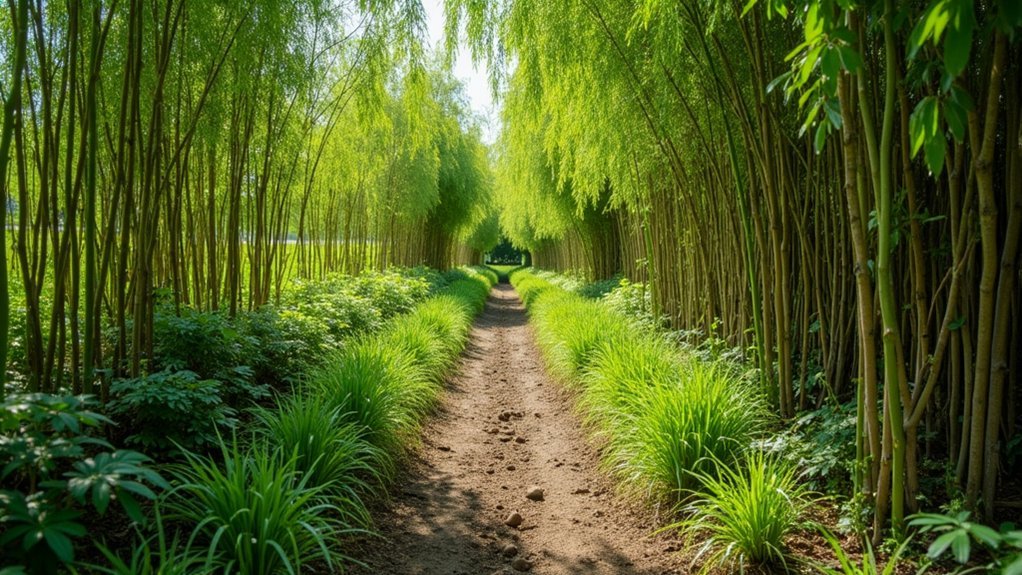
When battling persistent soil erosion, willow trees stand out as remarkable natural allies. Species like Salix babylonica establish extensive root systems that effectively stabilize vulnerable soil within just 2-3 growing seasons.
Nature’s engineers, willow trees combat erosion by weaving underground networks that anchor soil where nothing else can.
You’ll find willows particularly effective in wetter areas and along riverbanks, where they absorb excess water and reduce damaging runoff during heavy rains.
They’re not just erosion fighters—these living fences provide valuable habitat for wildlife while attracting important pollinators with their early spring catkins.
To maintain your willow fence’s effectiveness, implement regular maintenance through pruning and pest monitoring.
With proper care, your willow barrier will combat soil erosion for years while simultaneously enhancing your property’s biodiversity.
It’s a natural solution that works with the environment rather than against it.
Hawthorn Hedgerows: Steep Slope Stabilization Solutions
Hawthorn’s extensive root network can reduce slope erosion by up to 50%, making it your top choice for stabilizing steep terrain when planted during fall or early spring.
You’ll create a wildlife sanctuary while solving erosion problems, as these thorny barriers provide nesting sites for birds and shelter for beneficial insects that enhance your garden’s ecosystem.
The plant’s adaptability to various soil conditions means you can successfully establish these protective hedgerows even in challenging environments where other erosion solutions might fail.
Root Structure Benefits
Among the many solutions for slope stabilization, hawthorn hedgerows stand out due to their remarkable root structure.
You’ll find these vegetative barriers particularly effective as they develop extensive root systems that penetrate deep into the soil, firmly anchoring the earth on steep inclines.
What makes hawthorn exceptional is its ability to reduce topsoil loss by up to 50% compared to unprotected areas.
When you plant these hedgerows, they considerably decrease water runoff while improving soil absorption, effectively preventing landslides and erosion.
As a native species in many regions, hawthorn adapts perfectly to local ecosystems and soil conditions.
Its thorny nature provides an added benefit by deterring grazing animals that might otherwise disturb the soil.
You’re not just preventing erosion—you’re supporting local biodiversity while securing your landscape.
Seasonal Planting Techniques
Timing your hawthorn hedgerow installation correctly can greatly impact its long-term erosion control effectiveness on steep slopes. For ideal results, plant during early fall or late winter rather than early spring, allowing root systems to establish before the growing season begins.
Assess soil conditions before planting—while hawthorns adapt to various soils, proper preparation enhances their ability to anchor and stabilize slopes. Loosen compacted soil and add organic matter if needed.
Regular maintenance during the first two years is essential. Prune your hawthorn hedgerows to encourage bushy, dense growth that maximizes their erosion-fighting capacity.
This practice increases lateral branch development, creating a more effective living barrier that can reduce soil loss by up to 50% compared to unprotected slopes.
Wildlife Habitat Integration
Beyond their erosion control benefits, hawthorn hedgerows transform steep slopes into vibrant wildlife sanctuaries.
These living fences create ideal habitats for birds and beneficial insects that contribute to your land’s ecological balance while their thorny structure protects vulnerable native plants from grazing animals.
You’ll notice increased biodiversity as your hawthorn hedge matures, providing nesting sites and food sources throughout the seasons.
The dense structure of these hedgerows helps combat soil erosion while simultaneously offering shelter to wildlife—a dual benefit for your land management strategy.
What’s more, these hedges sequester substantial carbon dioxide, with mature plants storing 600-800 pounds of carbon annually.
Vetiver Grass Barriers: The Living Soil Anchor System
When it comes to natural erosion control, vetiver grass stands as nature’s premier soil anchoring system. With roots extending up to 10 feet deep, this remarkable living fence securely binds soil on even the steepest slopes, dramatically reducing erosion during heavy rainfall.
You’ll appreciate vetiver’s clumping growth habit that creates natural barriers, slowing water runoff and improving infiltration. Once established, you won’t need to worry about extensive maintenance, making it a cost-effective solution for long-term erosion management.
Beyond erosion control, vetiver grass contributes to climate change mitigation by sequestering 600-800 pounds of CO2 annually per mature planting.
It’s also a soil health booster, increasing organic matter and enhancing nutrient availability throughout your landscape—truly a multifunctional champion for sustainable land management.
Native Shrub Selections for Region-Specific Erosion Protection
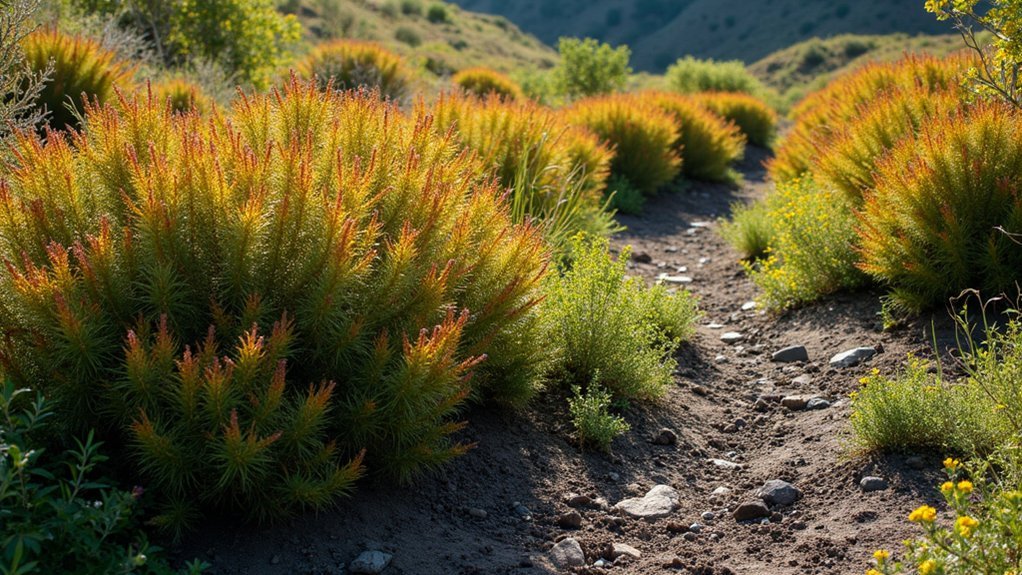
Native shrubs native to your specific region offer superior erosion protection while supporting local ecosystems in ways imported species simply cannot match. Your plant choices matter considerably when tackling soil stabilization challenges on your property.
| Native Shrub | Erosion Control Benefit |
|---|---|
| Willow (Salix spp.) | Extensive root systems stabilize waterways and slopes |
| Dogwood (Cornus spp.) | Prevents soil loss while attracting pollinators |
| Elderberry (Sambucus) | Reduces topsoil loss by up to 50% on disturbed land |
| Serviceberry (Amelanchier) | Creates effective barriers while providing seasonal fruit |
When you select shrubs adapted to your local rainfall and soil conditions, you’ll achieve more effective erosion control while creating habitat for local wildlife. These indigenous options establish quickly and require less maintenance than non-native alternatives.
Bamboo Boundaries: Fast-Growing Erosion Defense Networks
Bamboo varieties offer remarkable erosion control benefits while growing at speeds that outpace virtually all native shrub options.
You’ll find their extensive root systems penetrate deep into soil, anchoring loose particles on even the steepest slopes. Some bamboo species grow an astonishing 3 feet daily under ideal conditions, quickly establishing natural barriers that slow water runoff.
- Black Bamboo (Phyllostachys nigra) thrives in various soil types while providing sturdy erosion protection
- Umbrella Bamboo (Fargesia murielae) offers non-invasive erosion control perfect for smaller properties
- Dense bamboo groves increase water absorption during heavy rainfall events
- Fast-growing bamboo barriers require minimal maintenance once established
- Beyond erosion control, bamboo boundaries enhance biodiversity by creating wildlife habitat
Switchgrass and Prairie Plants for Waterway Protection
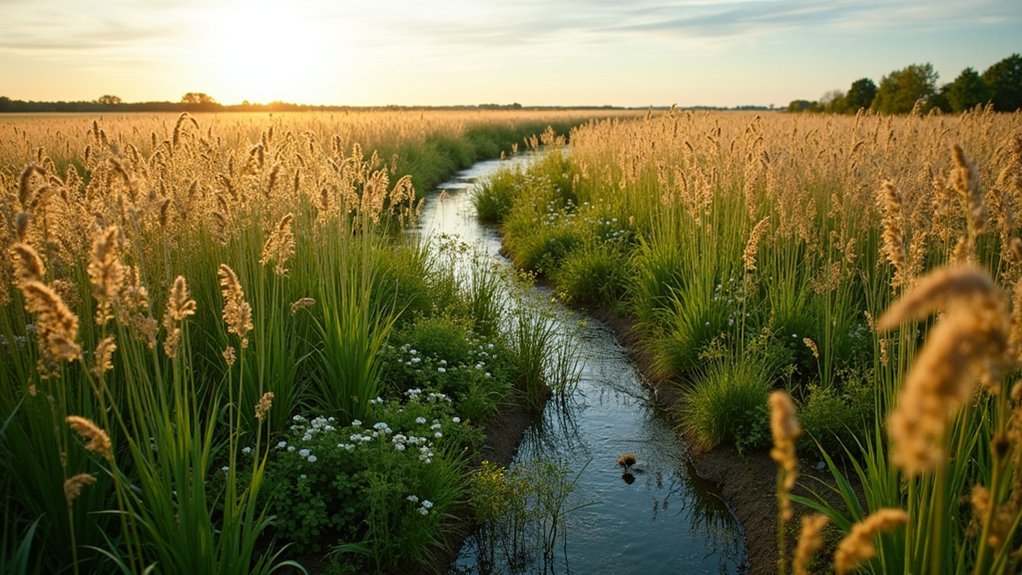
Unlike their woody counterparts, switchgrass and native prairie plants form living fences that excel specifically at protecting vulnerable waterways from erosion damage. Their extensive root systems penetrate up to 10 feet deep, anchoring soil while improving water infiltration by reducing surface runoff by up to 50%.
You’ll benefit from switchgrass’s remarkable ability to establish buffer zones that filter pollutants and excess nutrients before they contaminate aquatic ecosystems. These living barriers not only combat soil erosion but also enhance water quality in adjacent streams and rivers.
When you plant these native prairie plants along waterways, you’re also contributing to climate change mitigation—they sequester 600-800 pounds of carbon annually.
Their dense growth pattern and impressive root architecture make them ideal natural solutions for stabilizing banks while supporting local biodiversity.
Layered Root Systems: Multi-Species Approaches to Soil Retention
When designing effective living fences, combining multiple plant species with varying root depths creates a powerful defense against soil erosion.
You’ll achieve up to 50% better soil retention compared to traditional fencing by implementing layered root systems that work together to stabilize your property.
- Pair deep-rooting willows and dogwoods with shallow-rooted species to create a thorough soil-anchoring network.
- Incorporate native shrubs like elderberries and viburnums alongside oaks and hawthorns for enhanced biodiversity.
- Multi-species living fences provide wildlife habitats while accumulating organic matter that improves soil health.
- The combination of different root structures improves soil structure, particularly beneficial on sloped areas.
- Your erosion prevention strategy becomes more resilient when diverse plant species work together, creating a living infrastructure that strengthens over time.
Drought-Resistant Living Fences for Arid Erosion Control
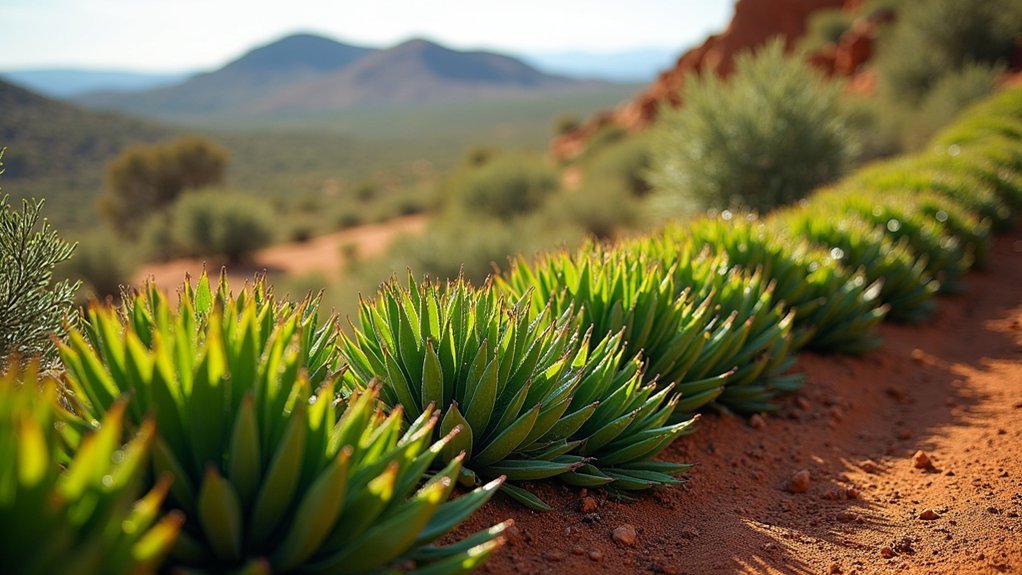
In regions where water scarcity presents additional challenges to erosion control, drought-resistant living fences offer a robust solution that thrives under harsh conditions.
Species like junipers and barberries develop extensive root systems that anchor soil effectively, preventing erosion even during prolonged dry periods.
You’ll find Native plants such as desert willows and mesquite trees particularly valuable, as they require minimal water while providing habitat for local wildlife.
Beyond erosion control, these living barriers actively combat climate change through carbon sequestration—mature hedgerows can capture 600-800 pounds of carbon annually.
You’ll also appreciate the economic benefits, as drought-tolerant fences can slash maintenance costs by up to 80% compared to traditional options.
The dense planting structure slows water runoff, enhancing soil absorption and creating healthier ecosystems in your arid landscape.
Coastal Erosion Barriers: Salt-Tolerant Living Fence Options
Your coastal property needs salt-tolerant defenders like beachgrass and sea oats that create powerful erosion barriers through their extensive root systems.
These specialized plants can withstand salt spray and coastal conditions while their deep roots anchor sandy soils against wave action and strong winds.
You’ll find that native coastal shrubs such as saltbush and bayberry complement these grasses perfectly, creating a multi-layered defense system that protects your shoreline while supporting local wildlife.
Salt-Tolerant Coastal Defenders
Coastal properties face unique erosion challenges that demand specialized living fence solutions. Salt-tolerant living fences offer natural protection while enhancing your shoreline’s biodiversity. Native species like black locust and bayberry thrive in saline environments, their robust root systems anchoring soil against wind and wave erosion.
- Beach grass and salt marsh hay effectively stabilize sandy coastal soils.
- Sea oats’ extensive root systems trap sand and protect vulnerable shorelines.
- Elderberry and juniper shrubs combat erosion while providing wildlife habitat.
- These natural barriers reduce the need for artificial structures and ongoing maintenance.
- Properly established salt-tolerant fences create self-sustaining coastal defense mechanisms.
You’ll find these living fences not only protect your coastal property but also contribute to the overall health of your local ecosystem, creating a resilient boundary that works with nature rather than against it.
Beachfront Root Systems
Three critical root structures define effective beachfront erosion barriers—fibrous, taproot, and rhizomatous systems. These specialized adaptations enable salt-tolerant plants to anchor sand and shield coastlines from storm damage.
When selecting native coastal plants for your beachfront property, consider their root architecture and erosion-fighting capabilities:
| Plant Species | Root System | Erosion Control Capacity |
|---|---|---|
| Beach Grass | Fibrous | Excellent sand stabilizer |
| Sea Oats | Rhizomatous | Creates living dunes |
| Beach Plum | Taproot | Stabilizes deeper soil layers |
| Salt Marsh Cordgrass | Fibrous | Superior salt tolerance |
| Bayberry | Fibrous/Taproot | Wildlife habitat provider |
Measuring Success: Soil Retention Rates of Different Living Fence Systems
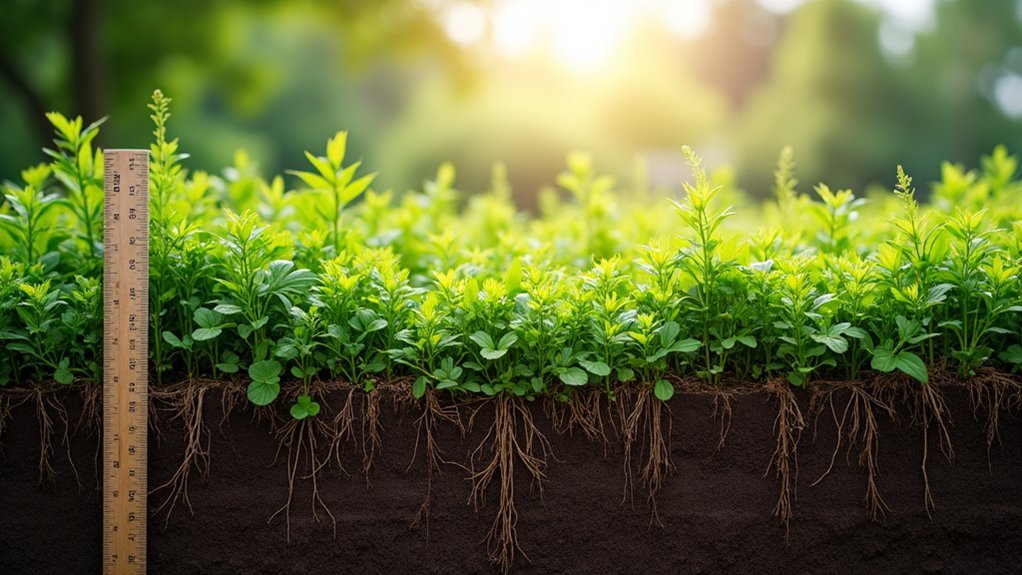
When evaluating the effectiveness of living fences for erosion control, quantifiable results provide the clearest picture of success.
You’ll find impressive soil retention rates across various living fence systems, particularly when using native species adapted to your local conditions.
- Willow and dogwood fences can reduce topsoil loss by up to 50% on slopes.
- Mature hedgerows sequester 600-800 pounds of CO2 annually while building soil health.
- Deep-rooted vegetation stabilizes banks and prevents waterway erosion.
- Vegetative barriers improve water filtration and soil absorption during heavy rainfall.
- Drought-tolerant species like juniper provide excellent erosion control in arid regions.
Frequently Asked Questions
What Is the Best Species for a Living Fence?
For a living fence, you’ll find fast-growing willows and dogwoods excellent choices. They’re versatile, establish quickly, and create effective boundaries. Consider thorny hawthorn if you’re looking for added security around your property.
What Is the Best Plant to Stop Soil Erosion?
You’ll find willows and dogwoods are excellent choices to stop soil erosion. Their extensive root systems stabilize soil effectively, especially on slopes and near water. Native grasses also reduce topsoil loss by up to 50%.
What Is the Best Low Maintenance Plant for a Fence Line?
You’ll find native species like juniper and barberry ideal for your fence line. They’re drought-tolerant and require minimal care once established. Evergreen arborvitae also offers year-round coverage with very little maintenance needed.
How Long Does It Take to Grow a Living Fence?
You’ll see living fences establish in 2-3 seasons with fast-growing species like willow, while slower varieties like holly take 5-7 years. The timeline depends on your climate, soil conditions, and maintenance efforts.
In Summary
Remember, you’re not just building a fence—you’re creating a dynamic ecosystem that fights erosion while enhancing your landscape. Choose species that match your region’s climate and soil conditions for best results. With proper maintenance, your living fence will strengthen over time, continuously improving soil retention. Start small, expand gradually, and you’ll soon enjoy both the practical benefits and natural beauty of this sustainable solution.

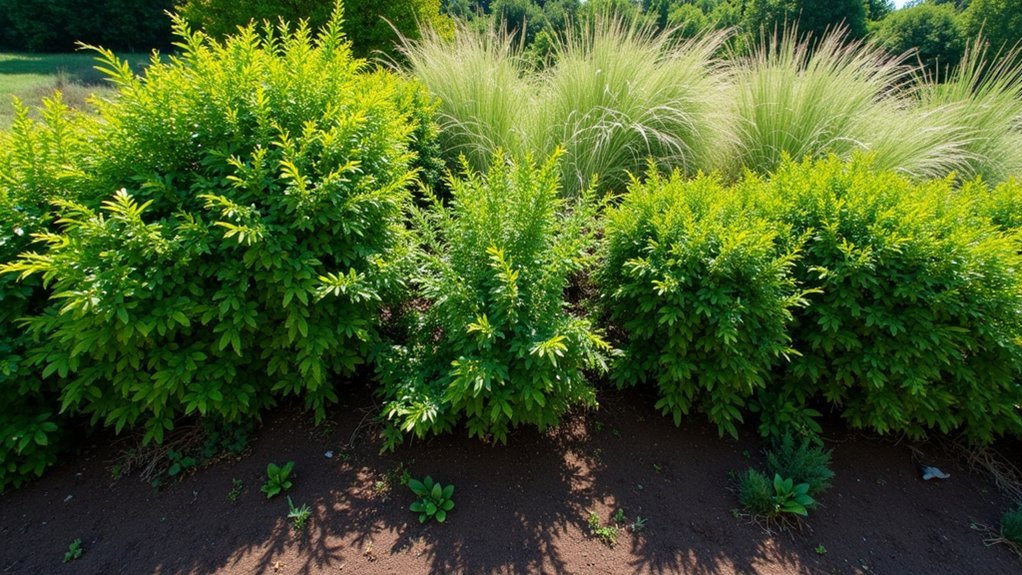



Leave a Reply